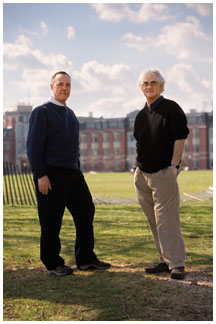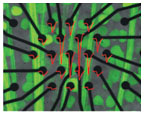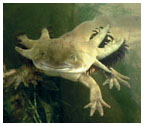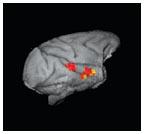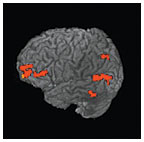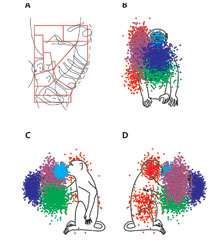
|
April 18, 2007: Features
Professors David Tank, left, and Jonathan D. Cohen stand by the site of the future home of the neuroscience institute, which is planned for completion in 2012. The institute, near Bloomberg Hall, Scully Hall, and the Icahn Laboratory, will be one of the first buildings visitors see when they arrive on campus from Washington Road. |
Mind
matters
A new neuroscience institute promises to fast-track
Princeton research on the brain
By Brett Tomlinson
Though it went unnoticed by outsiders, those in the know could see for years that Princeton steadily but quietly was becoming a force to be reckoned with in the hot field of neuroscience. It was unusual, to be sure — after all, Princeton has no medical school with which to conduct clinical research — but there they were: the new faculty members in molecular biology and psychology who study the brain; collaborators in places as unlikely as physics, computer science, even philosophy; undergraduates signing up for the new neuroscience certificate program, and grad students delving into the mysteries of the mind. What Princeton lacked, physics professor William Bialek says, was “a sign on the door.”
“There was this perception that Princeton didn’t have a neuroscience program, but if you looked at who was here, [Princeton] was a great place,” Bialek says. “It wasn’t very big, but the individuals were fantastic. In order to make it easier to recruit and make it clear to the students where the excitement is, you need the sign on the door.”
In November 2005, after reviewing a proposal prepared by professors David Tank and Jonathan D. Cohen, the University took an important step toward announcing the program’s presence by creating the Princeton Institute in Neuroscience, an interdisciplinary collection of researchers working on experimental and theoretical problems in the field. In the next five years, the institute will get more than a sign on the door: A new building complex, designed by José Rafael Moneo Arquitecto, will house the institute and the psychology department, allowing Princeton’s top minds in neuroscience to work side by side. Construction is slated to begin in 2009, with completion expected in 2012. Its location, south of the Carl Icahn Laboratory, will make the institute one of the first buildings visitors see when they arrive at Princeton from the south end of Washington Road.
Modern neuroscience is rooted in biology and psychology, supported by fields such as applied mathematics and physics, and increasingly tied to concepts in the humanities and social sciences such as moral reasoning and economic decision-making. Princeton seems well equipped to negotiate that web of interdisciplinary connections, faculty say, because of its strengths in key departments and an atmosphere that allows researchers to collaborate on fundamental questions involving the brain: questions about what makes us human, what enables us to think, how the brain is organized, and how it forms memories, makes decisions, and gives rise to emotions. These issues already are being examined in Princeton labs, and the list will grow as the neuroscience faculty expands. One of the strongest backers of the neuroscience initiative is President Tilghman, who has said on several occasions that if she were beginning her career today, she would go into that field.
Molecular biology professor Carlos Brody, the first major hire of the new neuroscience initiative, arrived in January. A talented computational neuroscientist and theorist, Brody studies the mechanisms of working memory, the short-term retention that enables us to dial phone numbers and hold conversations. A second recruitment is under way, according to Provost Christopher Eisgruber ’83. And as the faculty grows, Princeton plans to add to its undergraduate course offerings. In 2008–09, it will roll out an innovative set of quantitative neuroscience classes for juniors and seniors, following the path of “An Integrated, Quantitative Introduction to the Natural Sciences,” the multifaceted six-course science curriculum for freshmen and sophomores introduced by professors at Princeton’s Lewis-Sigler Institute for Integrative Genomics in the fall of 2004.
Princeton is not alone in its fascination with neuroscience. At U.S. colleges and universities, there are more than 300 training programs in the field, and the most recent annual meeting of the Society for Neuroscience, the field’s leading professional group, drew more than 25,000 people. Two top publications, The Journal of Neuroscience and Nature Neuroscience, say that submissions have doubled within the last decade. To succeed in this growing competitive environment, Princeton will have to find its niche and pursue areas of research in which it can excel, according to Cohen, a psychology professor who serves as co-director of the institute along with Tank, a molecular biologist.
In mathematical and computational modeling of brain systems, for instance, Cohen says that Princeton’s intellectual resources put it in an “elite cohort” of universities, along with schools like MIT and Caltech. Princeton also plans to build on its strengths in the development of theoretical approaches to neuroscience and the use of innovative technology in brain-imaging studies and microscopy. But the institute has no illusions of competing with medical schools in clinical research — professors may collaborate with colleagues at medical colleges, but the work done at Princeton is more likely to end up in the pages of textbooks than on prescription pads.
Cohen and his colleagues have larger long-term ambitions in mind, including fundamental principles that describe how the brain works. Neuroscientists have been adept at collecting large amounts of data, Cohen says, and while that is crucial, on its own it has limits. For example, he explains, suppose we were able to identify the nature and location of every atomic particle in the universe. That would be useful, but we would still need to understand the laws of how particles interact. “Similarly, just a catalog of all the neurons in your brain and how they’re connected wouldn’t tell me how it works,” Cohen says. “I don’t want to say it wouldn’t be an advance, but it wouldn’t give me what I want to know as a scientist: the principles of operation. It wouldn’t allow me to predict what’s going to happen next. ... That’s something on which we wish to focus.”
Cohen and Tank are heading the recruiting efforts aimed at pushing Princeton to neuroscience’s leading edge. Tank has experience bridging disciplines; his four job titles in the University directory include an appointment in the physics department. Before coming to Princeton, he helped to pioneer imaging technologies in neuroscience, and his reputation for mentoring talented researchers makes him a “magnet” in drawing faculty and graduate students, according to molecular biology professor Sam Wang, one of Tank’s protégés. “When it comes to the junction of experiment and theory, David is the world leader,” Wang says.
Cohen, who studies how the brain guides attention, thought, and action, also is a top researcher with a knack for recruiting. He has made a career of diving headfirst into new ventures. Originally trained as a medical doctor, Cohen switched to cognitive psychology after medical school. After earning his Ph.D. and building a research career at Carnegie-Mellon and the University of Pittsburgh, he left the comfortable lab facilities of an established medical college to help Princeton create its own neuroimaging lab. When asked to work on the proposal for a neuroscience institute, Cohen gladly agreed. “It was very clear the timing was right,” he says.
Studying the brain is a fascinating and worthwhile pursuit, but the field is filled with technical challenges. The human brain is “arguably the most complex device in the known universe,” Cohen notes, weighing about three pounds and containing billions of elaborately linked neurons. But the brain’s complexity is not simply a product of the quantity of its components. The individual components are extraordinarily complicated as well — and resourceful. The brain operates on 12 watts of power, about a third of the juice needed to light the bulb in a refrigerator. “It’s very hard to probe activity in something that compact and efficient,” says Wang.
Wang should know — his lab uses a state-of-the-art technique that digitally films the brain tissue of anesthetized rats about half a millimeter under the brain’s surface. In high resolution, Wang can monitor tiny neural impulses, made visible with the help of fluorescent dye. While the brief horizontal flashes on the black-and-white screen may seem unremarkable to the uninitiated, they represent a remarkable step forward for Wang and his colleagues: the chance to study an individual “action potential” — an electrical charge used to send signals — in a living brain. Still, he admits, “You have to love it to watch a lot of it.”
Wang’s work is just the latest in a neuroscience tradition at Princeton that spans the last few decades. In 1973, nine faculty members in three departments — psychology, biology, and electrical engineering — proposed making neuroscience the first interdisciplinary graduate program at Princeton, and in the years that followed, faculty members like Charles Gross and Bart Hoebel, both psychologists, anchored the University’s presence in the field. But the labs were few in number and specialized in their goals. “There wasn’t really a whole lot to talk with these other labs about,” recalls Michael Graziano ’89 *96, an assistant professor of psychology who began working in Gross’ lab as an undergraduate. “You’re working on the monkey visual system, and [another lab is] working on the rat appetite system — the difference was gigantic. It was a little isolating to all of us, I think.”
Starting in the late 1990s, Princeton hired faculty in hopes of building a critical mass in neuroscience, beginning with the return of John Hopfield, who had taught at the University from 1964 to 1980. Hopfield’s work spans several fields, but one of his most notable contributions, colleagues say, was showing how physicists could create theories and models that spurred new ideas for experiments in the biological sciences, particularly in neuroscience. After Hopfield’s arrival, Princeton drew Tank and Bialek away from high-level jobs in industry research (Tank at Bell Labs, Bialek at NEC Research Institute). Also in that wave of additions came Elizabeth Gould, whose innovative research at Princeton on the ability of adult mammals to produce new neurons has reversed a long-accepted neuroscience principle, and Cohen, who established the University’s fMRI facility at Green Hall in 2000.
The fMRI lab — formally, the neuroimaging facility of the Center for the Study of Brain, Mind and Behavior — has been the hub of the University’s burgeoning cognitive neuroscience community, and it was innovative from its birth. Princeton was the first institution to acquire an fMRI device for use outside a medical facility. In addition to paying a hefty price for the hardware, the University “primed the pump” by supporting the first wave of the facility’s research, Cohen says, enabling professors to develop interesting projects, attract outside funding, and recruit top graduate students and postdoctoral researchers.
With fMRI, researchers can see which parts of the brain are activated when a subject does what Cohen calls “characteristically, if not uniquely, human things” like solving problems or using spoken language. Changes in the brain’s blood flow are shown in tens of thousands of voxels, the volumetric equivalents of the two-dimensional pixels in a digital photograph, and while the resolution is relatively coarse, compared with the techniques used by molecular biologists like Wang, fMRI has provided a trove of data for several important studies. In the last seven years, Princeton professors have used fMRI to study memory, vision, and a variety of interdisciplinary topics, collaborating with colleagues in the philosophy and economics departments.
Princeton’s fMRI facility also has provided undergraduates with unprecedented access, Cohen says, beginning with the second introductory course for neuroscience certificate students, taught by Sabine Kastner, an associate professor of psychology. “They design their own experiments, they scan in our facility, they analyze the data, [and] they learn how to interpret the data,” Kastner says. About a half-dozen students use the fMRI facility for senior thesis work each year.
Last fall, psychology major Taylor Beck ’07 began a thesis project to study how a person’s brain responds to different characters while reading a narrative. His initial idea, “This is your brain on Faulkner,” seemed a little too complex, so he selected a more simplified narrative medium: comic books. The characters are “maximally differentiated,” he says — Spider-Man is purely heroic, the Green Goblin starkly evil — so if the brain does register different patterns when conjuring one or the other, they should be easier to spot (or as easy as can be expected in 100,000 voxels). Beck and his advisers, Ken Norman in psychology and David Blei in computer science, are using complex pattern analysis to try to decipher the data. The jury is out on whether the results will prove fruitful, Norman says, but regardless of the outcome, Beck will leave Princeton with an intimate knowledge of lab procedures in cognitive neuroscience.
Beck’s thesis work touches on the importance of quantitative and computational neuroscience, a major emphasis in Princeton’s plans for the institute. Studying the brain often involves massive, unstructured sets of data, from which relevant details are extracted. In fMRI, researchers look for the patterns of activation that represent a memory or a brain function — “temporary constellations,” as Harvard professor Daniel Schacter poetically has dubbed them. Theorists in the molecular biology and physics departments sift through what we know about neural functions at the molecular level to create models of neural circuits that aim to explain how groups of neurons communicate and produce collective behaviors in the brain.
To tackle quantitative problems, neuroscientists have found helpful collaborators in quantitative areas such as applied mathematics, computer science, and the engineering departments. “Probability, statistics, differential equations — the basic tools are enormously portable from field to field,” says Philip Holmes, the chairman of the mechanical and aerospace engineering department, who collaborates closely with Cohen. “Mathematics has been an incredibly successful language with which to describe the world around us.”
Describing and understanding the brain is a pursuit often driven by broad questions, and the detailed answers that researchers find may seem minute in comparison to the overwhelming complexity of the brain. But as these incremental findings accumulate, they inch closer to significant clinical benefits. In the fMRI facility, Kastner studies how the brain filters visual information to focus on important features. Understanding that mechanism could help patients with attention-deficit hyperactivity disorder. Matthew Botvinick, an assistant professor of psychology, is using fMRI data and pattern analysis to study the brain’s representations of language, a first step that could lead to a clearer grasp of developmental dyslexia. Wang’s work in molecular biology includes examining how the cerebellum processes information, which might help clinical researchers who study autism.
“[Neuroscience] is where the frontier is,” Wang says, listing
some of the most ambitious ideas in neuroscience — regenerating
spinal cords, repairing brain damage, detecting and treating diseases
such as Alzheimer’s and schizophrenia. “Those are big things.
I might not live to see some of them, but that’s what we have in
the next hundred years.” ![]()
Brett Tomlinson is an associate editor at PAW.
Michael Berry places a retina from a tiger salamander, right, on an array of electrodes, magnified above. The red lines show the voltage pattern generated by a firing ganglion cell. |
In the lab
Michael Berry, associate professor of
molecular biology
An inside look at the active retina
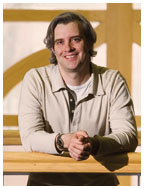 Michael
Berry’s primary interest is understanding the brain’s local
circuits — the small pieces that work together to complete larger
tasks such as recognizing a familiar face or throwing a ball — and
he has found a fascinating, controllable model circuit in the retinas
of salamanders, similar to those in the brain. In an extracted retina,
there is a flat layer of neurons, called ganglion cells, which send signals
from the retinal circuit to other circuits. Berry places the layer of
ganglion cells on a glass cover slide containing an array of metal electrodes.
The extracted cells continue to fire in response to light, and when the
cells fire, the electrodes instantaneously pick up the signal.
Michael
Berry’s primary interest is understanding the brain’s local
circuits — the small pieces that work together to complete larger
tasks such as recognizing a familiar face or throwing a ball — and
he has found a fascinating, controllable model circuit in the retinas
of salamanders, similar to those in the brain. In an extracted retina,
there is a flat layer of neurons, called ganglion cells, which send signals
from the retinal circuit to other circuits. Berry places the layer of
ganglion cells on a glass cover slide containing an array of metal electrodes.
The extracted cells continue to fire in response to light, and when the
cells fire, the electrodes instantaneously pick up the signal.
In experiments, Berry has found that the retina recognizes patterns of flashing light, and when the pattern is interrupted, a subset of ganglion cells sends a signal. Some of the ganglion cells in the retina also take notice when an object moving at a constant velocity reverses its direction. The findings indicate that local circuits are capable of processing information and making predictions about patterns. “We’re realizing that the retina isn’t just a passive filter,” he says. “It’s really a much more active circuit.”
Sabine Kastner’s “translational approach” aims to use fMRI scanning to connect similarities in the way that a monkey’s brain, left, and a human’s brain, right, respond when viewing the same stimuli. |
In the lab
Sabine Kastner, associate professor
of psychology
What we see and what we don't
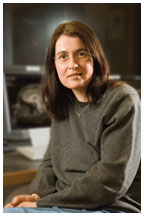 Sabine
Kastner, who came to Princeton in 2000 as one of the first faculty members
in the fMRI lab, studies how we “select information to guide further
behavior.” “That sounds a little abstract,” she says,
“but it’s a very important problem that you solve all the
time.” From the moment we open our eyes in the morning, we are bombarded
with visual information — much more information than our brains
can handle — so our brains have to choose which visual details will
inform our decisions as we move through our daily routines. For instance,
when people converse, they tend to concentrate on facial expressions and
filter out background details like the paintings on the wall or trees
and birds visible through a window. Certain conditions, such as autism
and attention-deficit hyperactivity disorder, affect the brain’s
ability to process visual information.
Sabine
Kastner, who came to Princeton in 2000 as one of the first faculty members
in the fMRI lab, studies how we “select information to guide further
behavior.” “That sounds a little abstract,” she says,
“but it’s a very important problem that you solve all the
time.” From the moment we open our eyes in the morning, we are bombarded
with visual information — much more information than our brains
can handle — so our brains have to choose which visual details will
inform our decisions as we move through our daily routines. For instance,
when people converse, they tend to concentrate on facial expressions and
filter out background details like the paintings on the wall or trees
and birds visible through a window. Certain conditions, such as autism
and attention-deficit hyperactivity disorder, affect the brain’s
ability to process visual information.
To get a better understanding of the circuits involved in selecting visual details, Kastner and other researchers have used invasive techniques to study brain activity in monkeys. But with animal subjects, there is always uncertainty about whether the mechanisms reflect what happens in the human brain. Kastner is quelling some of that uncertainty by using a “translational approach”: She conducts fMRI studies with both humans and monkeys to show that similar mechanisms are at work. Princeton is one of a few places in the world equipped to do fMRI scans on monkeys, Kastner says.
Michael Graziano’s research examines how monkeys control movement and understand space. The figure above shows the regions around a monkey’s body in which different kinds of hand actions tend to be performed. |
In the lab
Michael Graziano
’89 *96, associate professor of psychology
Muscles and joints, working together
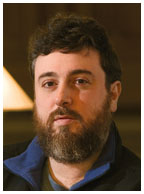 For
more than a century, researchers have viewed the motor cortex of a monkey’s
brain as a crude map — stimulate one spot and the hand twitches,
stimulate another and the mouth moves — but at the same time, says
Michael Graziano, many have suspected that the map analogy is not quite
right. For example, areas that controlled two different muscle groups
seemed to overlap in some instances, indicating that some areas of the
cortex might be involved in more than one aspect of movement.
For
more than a century, researchers have viewed the motor cortex of a monkey’s
brain as a crude map — stimulate one spot and the hand twitches,
stimulate another and the mouth moves — but at the same time, says
Michael Graziano, many have suspected that the map analogy is not quite
right. For example, areas that controlled two different muscle groups
seemed to overlap in some instances, indicating that some areas of the
cortex might be involved in more than one aspect of movement.
When Graziano changed the traditional map experiment, lengthening the
time of stimulation from 20 milliseconds to a full second, he observed
movements that were far more complex. Instead of just twitching, the hand
closed and moved toward the monkey’s mouth or reached out in a defensive
gesture, depending on the spot in the cortex that was stimulated. The
result supports the idea that the motor cortex integrates the movements
of several joints and muscles in ways that are useful for an animal’s
survival. In a general sense, the map is still there, Graziano says. “[But]
there’s an organization that’s not centered around individual
muscles. It’s centered around the kinds of movements that the animal
needs in its daily life.” ![]()

